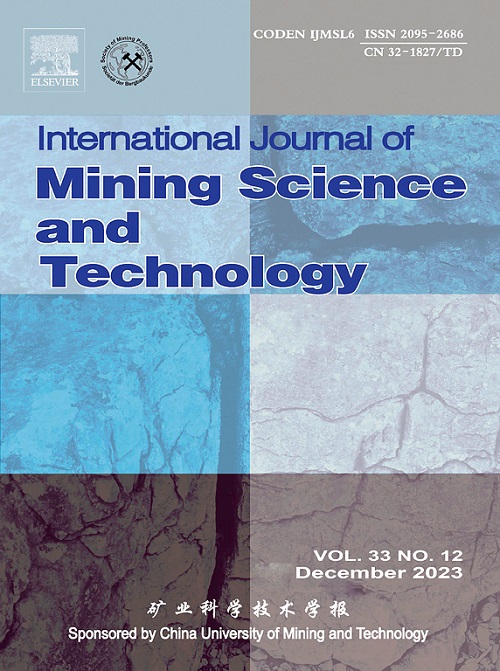Depth-dependent mechanical-seepage behavior and safety mining distance of the steeply inclined coal mine underground reservoir
IF 13.7
1区 工程技术
Q1 MINING & MINERAL PROCESSING
International Journal of Mining Science and Technology
Pub Date : 2025-08-01
DOI:10.1016/j.ijmst.2025.07.006
引用次数: 0
Abstract
Coal mine underground reservoir (CMUR) technology mitigates water scarcity in China’s coal-rich western regions but lacks tailored solutions for steeply inclined coal seams. This study develops a novel framework of steeply inclined coal mine underground reservoirs (SICMUR), which is a paradigm shift from conventional CMUR that the coal seam itself serves as the reservoir floor, challenging conventional designs due to depth-dependent permeability and mechanical constraints. Triaxial mechanical-seepage tests on Xinjiang Wudong coal samples (100, 200, 300 m depths) revealed a 3.5 MPa triaxial strength increase per 100 m depth and a 58-fold post-peak permeability surge at 300 versus 100 m. Similar model simulations revealed mining-induced stress redistribution and significant deformation effects, particularly subsidence and water-conducting fractures during lower coal seam mining. Results indicate a minimum 40 m safety distance between reservoirs and lower coal seams. Critical construction parameters were investigated for Wudong mine SICMUR as collapse zone heights (9.9–12.31 m) and water-conducting fracture zone heights (31.96–37.40 m). This work systematically bridges SICMUR concepts to field implementation, offering a framework for water preservation in steeply inclined mining while addressing safety concerns, providing a new approach for water reservation in steeply inclined coal mining.
急倾斜煤矿地下储层随深度的力学渗流行为与安全开采距离
煤矿地下水库(CMUR)技术缓解了中国西部富煤地区的水资源短缺,但缺乏针对大倾斜煤层的量身定制解决方案。该研究开发了一种新的急倾斜煤矿地下储层框架(SICMUR),这是传统的急倾斜煤矿地下储层框架的一种范式转变,该框架将煤层本身作为储层底板,由于深度相关的渗透率和机械约束,挑战了传统的设计。新疆武东煤样(100,200,300 m深度)的三轴力学渗流试验表明,每100 m深度三轴强度增加3.5 MPa, 300与100 m时渗透率峰值后激增58倍。类似的模型模拟结果显示,采动引起的应力重分布和显著的变形效应,特别是下煤层开采过程中的沉陷和导水裂缝。结果表明,储层与下煤层之间的安全距离最小为40 m。研究了武东矿SICMUR塌陷带高度(9.9 ~ 12.31 m)和导水破裂带高度(31.96 ~ 37.40 m)的关键施工参数。这项工作系统地将SICMUR概念与现场实施联系起来,在解决安全问题的同时,为大倾斜煤矿的保水提供了一个框架,为大倾斜煤矿的保水提供了一种新的方法。
本文章由计算机程序翻译,如有差异,请以英文原文为准。
求助全文
约1分钟内获得全文
求助全文
来源期刊

International Journal of Mining Science and Technology
Earth and Planetary Sciences-Geotechnical Engineering and Engineering Geology
CiteScore
19.10
自引率
11.90%
发文量
2541
审稿时长
44 days
期刊介绍:
The International Journal of Mining Science and Technology, founded in 1990 as the Journal of China University of Mining and Technology, is a monthly English-language journal. It publishes original research papers and high-quality reviews that explore the latest advancements in theories, methodologies, and applications within the realm of mining sciences and technologies. The journal serves as an international exchange forum for readers and authors worldwide involved in mining sciences and technologies. All papers undergo a peer-review process and meticulous editing by specialists and authorities, with the entire submission-to-publication process conducted electronically.
 求助内容:
求助内容: 应助结果提醒方式:
应助结果提醒方式:


